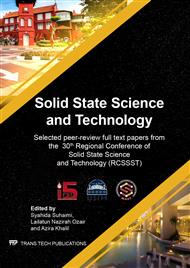[1]
Misenan M.S.M. and A.S.A. Khiar (2018). Conductivity, Dielectric And Modulus Studies of Methylcellulose-NH4TF Polymer Electrolyte. Eurasian J. Bio. Chem. Sci. 1(2): 59-62.
Google Scholar
[2]
Vincent C A (1987). Polymer electrolytes. Progress In Solid State Chemistry. 17(3):145-261. https://doi.org/10.1016/0079-6786(87)90003-3.
DOI: 10.1016/0079-6786(87)90003-3
Google Scholar
[3]
Buraidah, M H, A K Arof. ( 2011). Characterization of chitosan/PVA blended electrolyte doped with NH4I. Journal of Non-Crystalline Solids. 357 : 3261-3266.
DOI: 10.1016/j.jnoncrysol.2011.05.021
Google Scholar
[4]
Kadir M F Z, L P Teo, S R Majid, A K Arof. (2009). Conductivity studies on plasticized PEO/chitosan proton conducting polymer electrolyte, Materials Research Innovations. 13:191-194.
DOI: 10.1179/143307509x440460
Google Scholar
[5]
Pinotti A, M A Garcia, M N Martino, N E Zarithzky. (2007). Study on microstructure and physical properties of composite films based on chitosan and methylcellulose. Food Hydrocolloids. 21:66-72.
DOI: 10.1016/j.foodhyd.2006.02.001
Google Scholar
[6]
Tian, H, A, Z Tang, X. Zhuang, X. Chen. (2011). Biodegradable Synthetic Polymers: Preparation, Functionalization and Biomedical Application. Progress In Polymer Science. 37 (2): 237- 280.
DOI: 10.1016/j.progpolymsci.2011.06.004
Google Scholar
[7]
Kadir, M F Z., S R Majid, A K Arof. (2010). Plasticized Chitosan-PVA blend Polymer Electrolyte Based Proton Battery. Electrochemica Acta. 55: 1475-1482.
DOI: 10.1016/j.electacta.2009.05.011
Google Scholar
[8]
Hamdan K.Z,A.S.A Khiar. (2014). Conductivity and Dielectric Studies of Methylcellulose/ Chitosan-NHH4CF3SO3 Polymer Electrolyte. Key Engineering Materials, 594-595: 818-822.
DOI: 10.4028/www.scientific.net/kem.594-595.818
Google Scholar
[9]
Hafiza M N, M I N Isa. (2014). Ionic Conductivity and Conduction Mechanism Studies of CMC/Chitosan Biopolymer Blend Electrolytes. Research Journal of Recent Science. 3(11):50-56.
Google Scholar
[10]
El-Hefian E, Yahaya A H (2010). Effects of Temperature, Shearing Time and Rate of Shear on the Viscosity of Chitosan/Agar Blend Solutions. Maejo International Journal of Science and Technology. 4(2). 261-267.
Google Scholar
[11]
Misenan M. S. M., A. H. Shaffie, A. S. A. Khiar. (2018). Effect of BMITFSI to the Electrical Properties of Chitosan/ MethylCellulose Based Polymer Electrolyte. AIP Conference Proceedings 1972. 030001:.
DOI: 10.1063/1.5041222
Google Scholar
[12]
Misenan M. S. M., M. I. N. Isa, A. S. A. Khiar (2018). Electrical and structural studies of polymer electrolyte based on chitosan/methyl cellulose blend doped with BMIMTFSI. Material Research Express. 5 (5). https://doi.org/10.1088/2053-1591/aac25b.
DOI: 10.1088/2053-1591/aac25b
Google Scholar
[13]
Misenan M. S. M., E.S. Ali, A. S. A. Khiar. (2018). Conductivity, dielectric and modulus study of chitosan-methyl cellulose – BMIMTFSI polymer electrolyte doped with cellulose nano crystal. AIP Conference Proceedings 1972. 030001:.
DOI: 10.1063/1.5041231
Google Scholar
[14]
Sim, L.N., S. R. Majid, A. K. Arof (2014). Effects of 1–butyl–3–methyl imidazolium trifluoromethanesulfonate ionic liquid in poly(ethyl methacrylate)/poly(vinylidenefluoride–co– hexafluoropropylene) blend based polymer electrolyte system Electrochimica Acta 123.190–197.
DOI: 10.1016/j.electacta.2014.01.017
Google Scholar
[15]
Arellano et al., (2016). Computational insights into the molecular interaction and ion-pair structures of a novel zinc-functionalized ionic liquid, [Emim][Zn(TFSI)3]. Spectrochimica Acta Part A: Molecular and Biomolecular Spectroscopy. 153:6-15.
DOI: 10.1016/j.saa.2015.07.102
Google Scholar
[16]
Samsudin, A.S., Aziz, M.I.A., M. I. N Isa (2012). Natural Polymer Electrolyte System Based on Sago: Structural and Transport Behaviour Characteristics International Journal of Polymer Analysis and Characterization.8.600-607.
DOI: 10.1080/1023666x.2013.723846
Google Scholar
[17]
Ramlli M. A. & M. I. N. Isa (2016). Structural and Ionic Transport Properties of Protonic Conducting Solid Biopolymer Electrolytes Based on Carboxymethyl Cellulose Doped Ammonium Fluoride. Journal of Physical Chemistry B.
DOI: 10.1021/acs.jpcb.6b06068
Google Scholar


